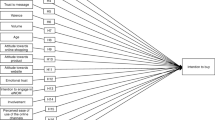Abstract
This study was designed to test two hypotheses:
H1: Reliable software, fulfilled promises and timely delivery of software can positively affect a software vendor's reputation and credibility.
H2: Dependence of customers on software vendors and extent of investment in software are negatively correlated with reliable software, fulfilled promises and timely delivery of software.
To measure the dependent and independent variables, a survey was sent to 500 IS managers and database administrators. Canonical correlation results show a positive correlation between reputation/credibility and reliable/on-time software and fulfilled promises. With respect to the second hypothesis, there was no correlation between the dependent and independent variables.
Similar content being viewed by others
References
J. Eliashberg and T.S. Robertson. New product preannouncing behavior: a market signaling study, Journal of Marketing Research, 25, (1988), 282–292.
A. Jenkins. Long overdue: the reasons behind vaporware, Computerworld, 22(40a), (1988), 11–13.
G. Casselman. Vaporware: vile or valid, Computing Canada, 17(26), (1991), 1, 5.
S.P. Dawson. Continuous improvements in action: applying quality principles to software, Information Systems Management, 11(1), (1994), 31–39.
G.P. Zachary. We're still waiting, Wall Street Journal, 12(102), (1994), R8.
E. Scannell and S. Johnston. Microsoft tardiness can derail developers, Computerworld, 28(21), (1994), 1, 14.
S.J. Johnston. Vaporware tactics elicit mixed views, Computerworld, 29(18), (1995), 1, 147.
P. Herbig, J. Milewicz and J. Golden. A model of reputation building and destruction, Journal of Business Research, 31(1), (1994), 23–31.
C. Shapiro. Consumer information, product quality, and seller reputation, The Bell Journal of Economics, 13(1), (1982), pp. 20–35.
N. Meachim. Users to vendors: quality, quality, quality, Datamation, 40(12), (1994), 38–45.
S. Kay. Poor communication equals vaporware, Computerworld, 26(2), (1992), 81–82.
W. Brandel. Late, unstable wares plague IS projects, Computerworld, 28(21), (1994), 1, 14.
M.A. Spence. Market Signaling (Harvard University Press: Cambridge, MA, 1974).
M. Engers. Signaling with many signals, Econometrica, 55, (1987), 663–674.
O.P. Heil and R.G. Walters. Explaining competitive reactions to new products: an empirical signaling study, Journal of Product Innovation Management, 10(1), (1993), 53–66.
P.M. Ippolito. Bonding and nonbonding signals of product quality, Journal of Business, 63(1), (1990), 41–60.
P. Milgrom and J. Roberts. Price and advertising signals of product quality, Journal of Political Economy, 94, (1986), 796–821.
A. Wolinsky. Prices as signals of product quality, Review of Economic Studies, 50, (1983), 647–658.
W. Boulding and A. Kirmani. A consumer-side experimental examination of signaling theory: do consumers perceive warranties as signals of quality? Journal of Consumer Research, 20, (1993), 111–123.
J. Eliashberg, T.S. Robertson and T. Rymon. Market signaling and competitive bluffing. Working paper, The Wharton School, University of Pennsylvania (1992).
K.K. Brockhoff and V.R. Rao. Toward a demand forecasting model for preannounced new technological products, Journal of Engineering and Technology Management, 10, (1993), 211–228.
P. Herbig and J. Milewicz. The relationship of reputation and credibility to brand success, Journal of Consumer Marketing, 10(3), (1993), 18–24.
T.J. Fitzgerald. Understanding the differences and similarities between services and products to exploit your competitive advantage, Journal of Services Marketing, 2(1), (1988), 25–30.
D.A. Hosage. Realware v. vaporware, Telecommunications, 19(2), (1985), 65–66.
W. Brandel. Product propaganda battle rages on, Computerworld, 28(22), (1994), 41.
K.S. Nash. Vendors fudge on product ship dates, Computerworld, 29(6), (1995), 81.
N. Weinberg, W. Brandel and S.J. Johnston. Users willing to ride Microsoft juggernaut, Computerworld, 29(6), (1995), 1, 28–29.
R. Hall. The strategic analysis of intangible resources, Strategic Management Journal, 13(2), (1992), 135–145.
E. Anderson and B.A. Weitz. The use of pledges to build and sustain commitment in distribution channels, Journal of Marketing Research, 29, (1992), 18–34.
S. Ganesan. Determinants of long-term orientation in buyer seller relationships, Journal of Marketing, 58(2), (1994), 1–19.
J.C. Nunnally. Psychometric Theory (McGraw-Hill: New York, 1967).
J. Stevens. Applied Multivariate Statistics for the Social Sciences (Lawrence Erlbaum Associates: Hillsdale, NJ, 1986).
M.S. Levine. Canonical Analysis and Factor Comparison (Sage: Beverly Hills, CA, 1967).
D. Stewart and W. Love. A general canonical correlation index, Psychological Bulletin, 70, (1968), 160–163.
P. Green. Analyzing Multivariate Data (The Dryden Press: Hinsdale, IL, 1978).
C. Shapiro. Premiums for high quality products as returns to reputations, The Quarterly Journal of Economics, 98, (1983), 659–679.
Author information
Authors and Affiliations
Rights and permissions
About this article
Cite this article
Garsombke, F.D., Garsombke, H.P. The Impact of Vaporware, Reliable Software, Vendor Dependence and Fulfilled Promises on Customers' Perceptions/Experiences and Vendor Reputation. Software Quality Journal 7, 149–173 (1998). https://doi.org/10.1023/A:1008816910677
Issue Date:
DOI: https://doi.org/10.1023/A:1008816910677




